AI, automation, drones, and genetic science are impacting the way we grow — from cucumbers, spinach, peppers, and even tropical fruit.
These innovations are all happening here on Canadian soil.
With a growing population, an affordability crisis and increasing food insecurity, greenhouses have emerged as a key player in the agri-food sector.
There’s a need — and huge opportunity on the table — for better quality food that is grown sustainably.
Canada’s greenhouse sector is a hotbed for growth — increasing sales for the 11th consecutive year — and up 9.2% to $2.5 billion in 2023, doubling in size from a decade ago.
A new report from the RBC Climate Action Institute launching next week, provides a lay of the land and highlights ways to transform indoor food production and its export opportunities.
How can Canada emerge as a leader in a low-carbon global food system?
To learn more, John Stackhouse visits the greenhouse capital of Canada, Leamington, Ontario and is joined by Peter Quiring, CEO at Nature Fresh Farms, Matt Korpan, Executive Director at the SEF Center for Horticultural Innovation and Lisa Ashton, Agriculture Lead at the RBC Climate Action Institute.
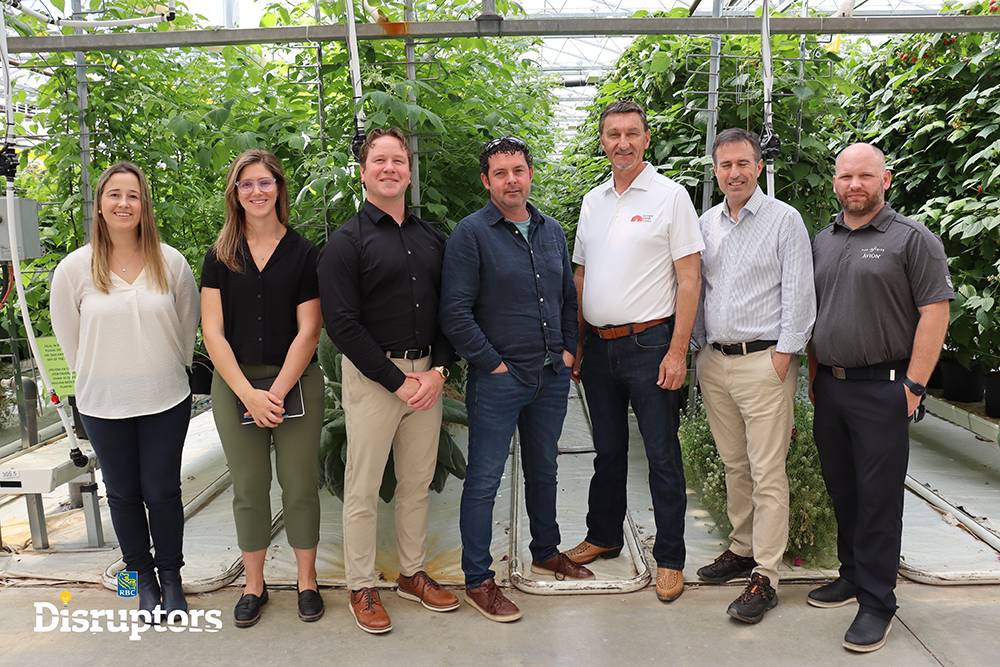
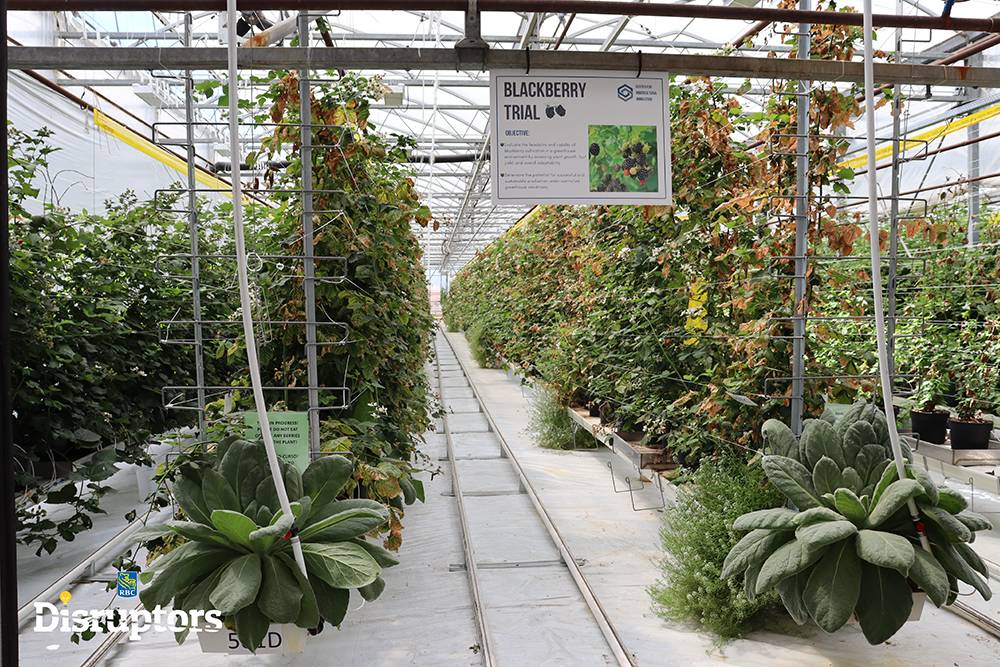
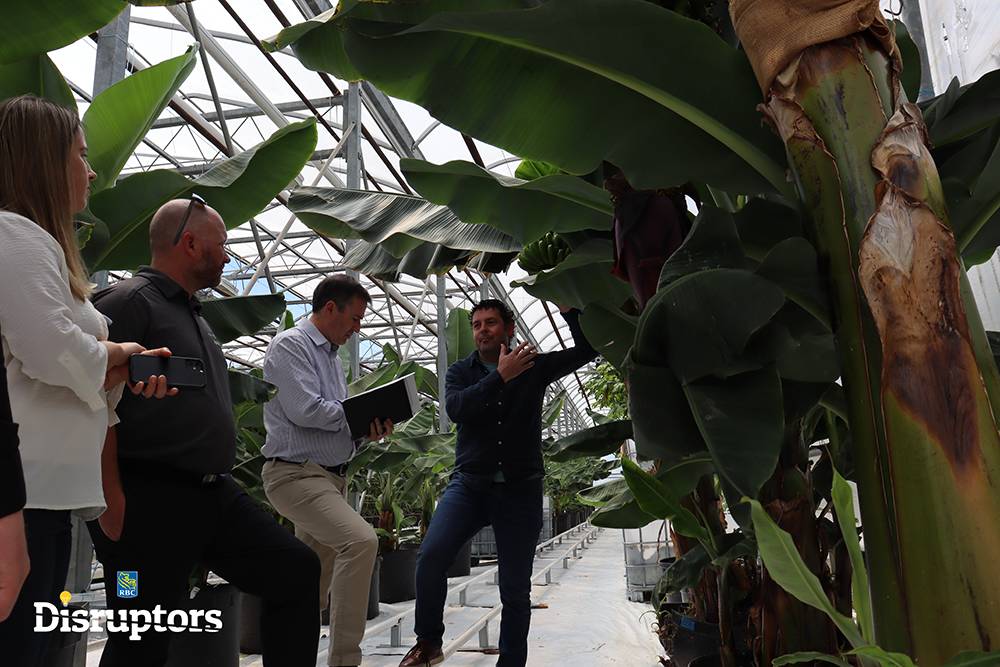
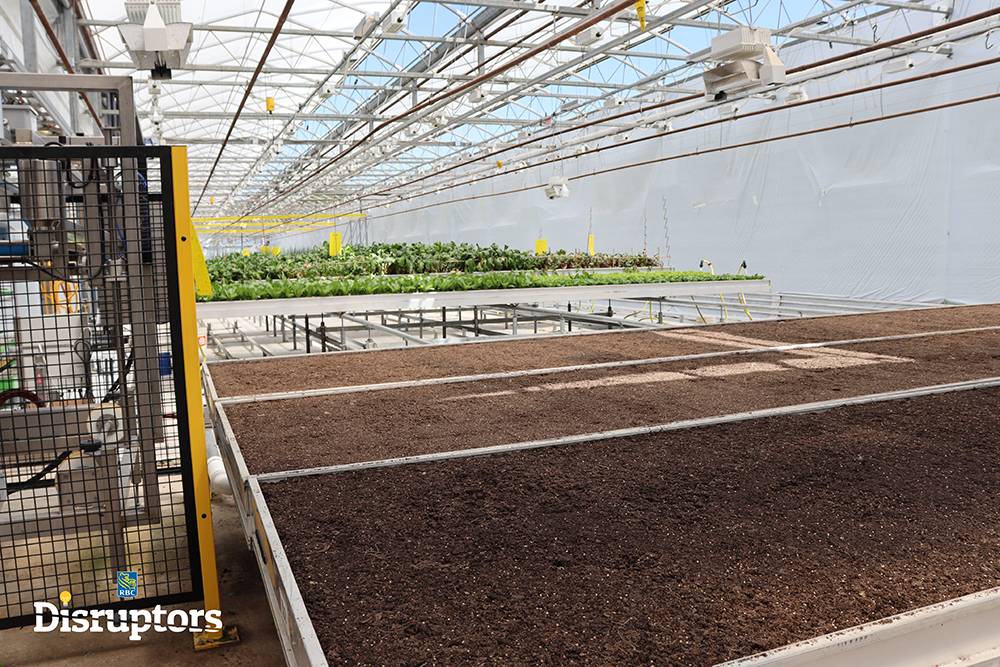
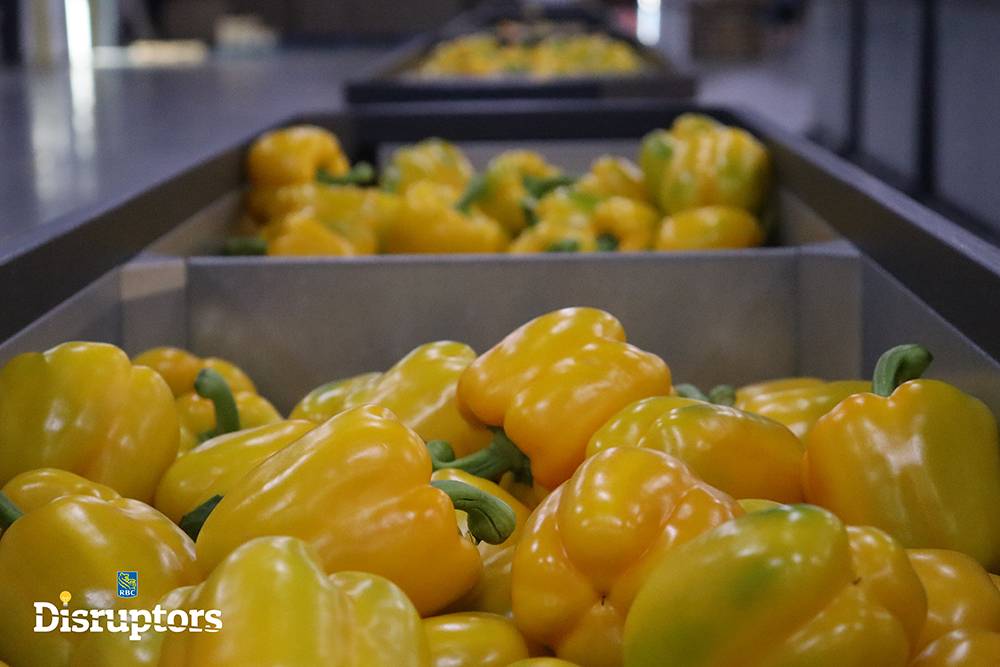
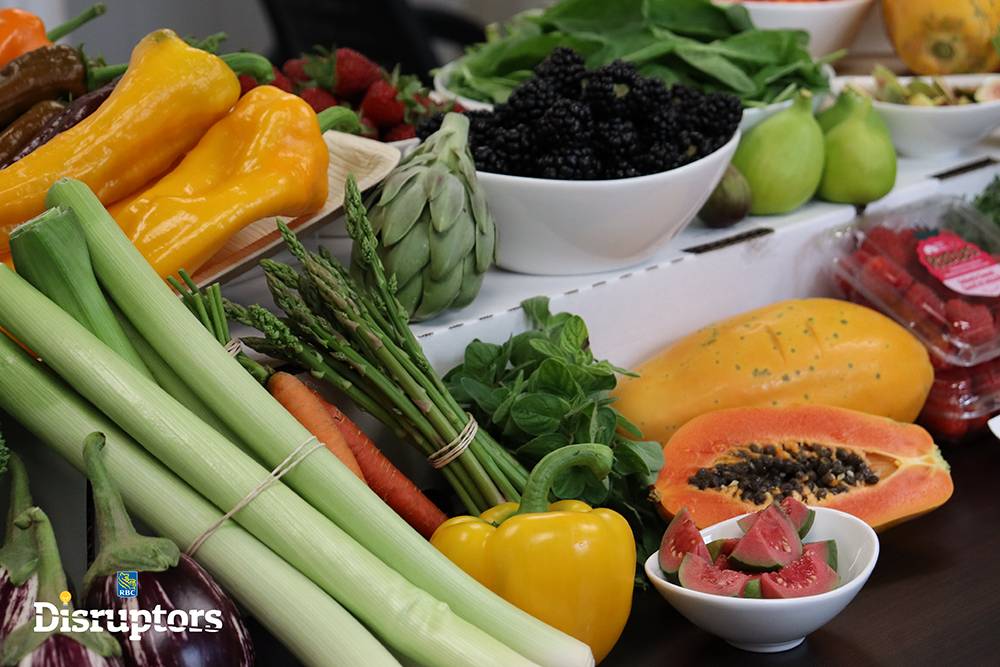
Canada’s greenhouse sector is a success story in growth and productivity — and can play a critical role in the Next Green Revolution — but it’s time to consider steps to support and expand sustainably.
By addressing infrastructure challenges, land-use efficiency and energy demand, the country can create ideal growing conditions for the sector to bloom further.
Speaker 1 [00:00:01] So we’re growing some guava here. We also have a whole lot of banana plants. I think we have the biggest banana farm in Canada. Down here, we actually see banana plants flowering and bananas growing. So we have a couple of big bunches of bananas right here that are just probably in about the middle of their growth stage. We have figs. And then here we have some papaya as well. Long before ten years from now, we’ll hopefully be in a new facility. And we may have one entire section dedicated to all kinds of cool and interesting exotic crops. We’re also actually growing some vanilla in another part of the greenhouse, and we’re working on coffee beans as well.
Speaker 2[00:00:43] That was the voice of Peter Quiring, who in some ways is the king of greenhouses in southwestern Ontario. Pete is the founder and CEO of Nature Fresh Farms, and is on a mission to transform the way we grow food in Canada. We’re in his experimental greenhouses outside Leamington, Ontario, where he has drones, robots, data centers, and a team of scientists innovating with ways to grow pretty much everything from cucumbers and spinach to guavas and vanilla and papaya. Maybe one day, even coffee. So pour yourself a cup and get ready for an eye opening conversation. This is disruptors and RBC podcast. I’m John Stackhouse. Peter Quiring is known as the Accidental Farmer. He started a machining business in 1993, now known as South Essex Fabricating, and in 1999 he built a greenhouse that he couldn’t seem to sell, so he decided to grow in it. And that’s when Nature Fresh Farms was born. More on that in a bit. With us, we also have Matt Korpan. He’s the executive director of R&D at the SEF Centre for Horticulture Innovation. It’s a dynamic institution striving to empower growers, improve crop productivity, and contribute to the long term sustainability and food security of the sector in Canada and beyond. And from the RBC Climate Action Institute, we’re joined by Lisa Ashton, our AG policy lead. Welcome all of you to Disruptors.
Speaker 3[00:02:20] Thank you for having me.
Speaker 2[00:02:21] Thank you.
[00:02:21] Pete, let’s start with the origin story. I mentioned you as the accidental farmer. How did this all begin?
Speaker 1 [00:02:29] I built greenhouses in the early 90s and saw better technology in other parts of the world, mainly Holland and Europe. And I couldn’t seem to get people to buy the technology in North America. So I convinced a few banker friends of mine to lend me some of the money to build the first greenhouse, which I thought I would sell as a turnkey growing solution. And it didn’t sell. So I already had an agronomist and a management team, and so we continued to just grow the crop. And a few years later we decided to double that. And then we continued to expand as time went on. We’ve actually sold some of the greenhouses now, but we still have over 250 acres that we grow in here and in the States. We also have a marketing arm which markets to all of the major retailers in North America.
Speaker 2[00:03:20] And as we’ve just seen through your greenhouse, and I’m looking at a table of some of your very colorful produce here, you’re doing much more than building greenhouses. What’s driving you to innovate in the way that we grow food?
Speaker 1 [00:03:33] Well, I see that with a growing population in the world, we need to get more innovative on how we grow food, and we need to grow better quality food. Also, people don’t want pesticides. We all are concerned about what that’s doing to us. So we want better quality food, we want more nutritious food, and we want food to be available and affordable for everybody. As we all know, currently food is becoming increasingly unaffordable for many people, even in Canada, nevermind other parts of the world. So one of our big goals here is to see how can we grow food more affordably.
Speaker 2[00:04:09] That’s a great ambition. Let’s start with the Leamington story. We’re surrounded by greenhouses. People may not appreciate that this is not only the greenhouse capital of Canada, it’s truly one of the key greenhouse centres in North America, if not the world. What’s so appealing about Leamington?
Speaker 1 [00:04:25] We are here. No, that’s not it. One of the really big things is that we’re surrounded by the Great Lakes, so we have a bit of a microclimate. We have more sunshine here than even 20, 30 miles away. Once the industry started to grow, a lot of the suppliers started to show up here, including South Essex and others. We have fertilizer at a phone call away. We have biological companies that provide us with good bugs to fight the bad bugs so we can avoid pesticides. We have lighting companies, mechanical companies. Just everything is right here.
Speaker 2[00:05:00] And a lot of really interesting technology that we’ll get into. From robotics to drones to some really interesting science in your labs here. I wonder if for a moment, Lisa, I can turn to you to zoom out and give us a sense of how big the opportunity here is. What’s the potential?
Speaker 3[00:05:18] Greenhouse production of fruit and vegetables has a significant opportunity ahead of them. And diversifying production, innovating in automation and sustainability, and expanding production to meet the growing domestic and international demand. And they are actually building from a really solid foundation with year over year growth for the past decade, with farmgate values at over 2.5 billion.
Speaker 2[00:05:41] And it’s going to take a lot of innovation, built on some impressive records of innovation here. Matt, I wonder if you can give us a sense of the scale of innovation in the sector. Most people, when they think about greenhouses, probably don’t think about a tech centre. And yet we’ve just walked through one of the most impressive tech centers I’ve seen in any part of the Canadian economy.
Speaker 4 [00:06:04] Well, it’s interesting we say this a lot. We’ve got tools now that we didn’t have before. Five years ago, ten years ago, things like lighting controls were existent, but not really being utilized. And now with LED technology, we can now change the spectrum of light. So that’s one example we talk about a lot. So innovation and growing strategies our knowledge of plants and crops has come a long way. And it’s the reason we call it controlled environment, agriculture, because we have control of all the conditions required to produce the kind of crops that everybody needs from the grocery store. So whether it’s lighting, humidity, climate to water, irrigation and then the genetics behind the breeding that develops these kind of things. It’s come a long ways. As well as the drones, the vision technology, AI is becoming a big part of what we do. We’ve got a talented guy on our team who write scripts and programs that can see something that humans maybe can’t see in our crops or in our growing strategies. So there’s so much potential there.
Speaker 1 [00:07:03] Give us a sense of what those drones and AI systems are doing.
Speaker 4 [00:07:08] Sure. A few examples that we’re currently using at the moment. One being in some of our lettuce crops. We’ve got cameras that go over the crop and we’ll count the number of plants for germination rates. Those are things that are either timely or take a lot of time and are very difficult to deal with with human labor, but it takes seconds to do it now with the drone technology. So at night, we’ve got cameras in the greenhouse that scan the crops, and they can see moths or weevils or bugs flying around that we don’t typically see during the day. And the drone then will get instructions from the camera to go out and kill the bug, and then come back and wait for the next bug to fly by. And it’s really fascinating what we can do now, which we didn’t have that capability before.
Speaker 1 [00:07:50] I hope you can license that so I can use it in my backyard. That sounds like a terrific opportunity.
Speaker 4 [00:07:55] We’ll work on it.
Speaker 1 [00:08:00] Pete, tell us some of the operating challenges. These are fascinating experiments and scaling it to a commercial level. Even for something as basic as the strawberry, is an interesting challenge. As an entrepreneur, as a business builder, what are the key challenges in your mind to scaling these innovations that Matt was describing?
Speaker 3[00:08:20] We don’t actually start with an economic model when we’re doing research and development. We start with what are the challenges? Just the basic growing challenges. Climate, lighting, watering pests. If it looks like it might be economically viable, we don’t start with the economics. Next we start with let’s just do it. We try to overcome as many challenges as we can to be as productive and economical as we can. And usually the economics are as simple as this. What’s the retail price of the product currently, and can we grow it on a large scale? Because economies of scale are probably the one big thing that’s made this industry so very competitive over the last couple of years. And so we need to grow at a 30, 50, 100 acre scale. And then the economies all of a sudden fall into line. And you can afford the automation and the robotics and all of that. Another thing to really consider is there’s a really big difference between AI, robotics and automation. Those are not the same thing. AI is very advanced, and I think it’s going to get way more advanced. Robotics is not nearly as far as we think. We can’t even make a vacuum cleaner that works properly. So picking tomatoes robotically or any other crop is a really big challenge. Automation, on the other hand, I think we’re really good at automation these days, so we take all of those things into consideration, including working with seed companies, fertilizer companies, the bio companies that provide the good bugs to fight the bad bugs, automation companies, mechanical companies. We have a lot of our own ideas, obviously, and because we have a fabricating shop, we can make a lot of the things that we can dream up. We like to say that there’s no idea. Too crazy. We’ll try almost anything. In fact, we have tried some really crazy things.
Speaker 1 [00:10:15] You’re trying coffee in Leamington Ontario.
Speaker 3[00:10:18] Yeah. I mean, we’re growing papaya. We’re growing bananas. We have the biggest banana farm in Canada. I think. We’re open to be challenged on that.
Speaker 1 [00:10:27] You’ve got an impressive business model going here from the fabrication, where you’re making greenhouses for others to those core produce and then the experimental side. So that’s not a bad way to run a business. But you mentioned a really important word there, important for innovation, which is scale. And it’s Canada’s inherent challenge. We’re a small market, yet we’re next door to the world’s most affluent market. How are you thinking about scaling your business and the sector more broadly in terms of the what people would call the total addressable market?
Speaker 3[00:11:01] Well, Nature Fresh grows on both sides of the border, and we market on both sides of the border. Although at least 75% of what we grow here in Leamington gets sold to the US. We also build greenhouses in the U.S., so we’re on both sides of the border there as well. The U.S. market is extremely important to us. We would love to serve other markets, whether it’s Europe or China or any other place. But geographically, that’s a really big challenge. We have some rules around organic growing that don’t make a lot of sense. We’re trying to effect change in that area. The US is much more competitive, growing organically than we’ve been Canada’s.
Speaker 1 [00:11:38] Why is that?
Speaker 3[00:11:40] We need a certain amount of meters of soil per square meter where the US doesn’t. The thinking is that the plants get their nutrients from the soil, when in fact, without introducing fertilizer, you couldn’t grow a crop anyway. It’s the nutrients that provide the nutrients, not the volume of soil. Actually, the bigger volume of soil makes it more challenging to grow. So we would like to be at parity with the US and organic growing, for example.
Speaker 1 [00:12:08] Talking about quantity, I wonder if I can also ask you, Matt, about quality, because people need think only of industrial farming and that reduce prices, but also compromise quality, over the last many decades. The food that you’re producing here is high quality. The tastes are unique. How do you do that?
Speaker 2[00:12:27] Well, Control Dragons is about having that control in a greenhouse environment. We can always produce conditions for the plant that are better than outside. Wind stress, rain or extreme sunlight. It all affects the crops that are grown in the outdoor environment. So we can grow high quality. And we know this. We believe that consumers expect high quality from us. So that’s kind of the focus for us when we’re growing. And in those strategies we use every plant, every crop here needs a different approach to growing. And our job is to figure out what that is and then we can take that knowledge and transfer it to the growers in our community and keep quality top of mind. Really, that’s what sets our industry apart from some of the other produce that’s out there is the quality is better.
Speaker 1 [00:13:09] There’s also the question about climate impact. And Lisa, I wonder if you can give us a brief sense from your research of what the outlook is on that front. One of the challenges that we’ve tried to lay down for the country is how do we grow more food with fewer emissions? We think that can be Canada’s moonshot, but what are you seeing?
Speaker 3[00:13:28] Canada’s green host sector is an untold success story of productivity and growth, and to build upon that growth in the future, the industry has key energy, water and waste infrastructure challenges that need to be overcome. Energy use, for example, is a key contributor to greenhouses carbon footprint. Their expenses and productive regions like Leamington are seeing increasing demands for the energy that is available, and we are seeing that innovative solutions are underway, but they need to be scaled to bring down emissions, bills and demand.
Speaker 1 [00:14:05] I wonder if you can tell us a bit about what you’re doing on the energy front. Maybe start with a bit of, one on one. For people who may not appreciate how much energy is required to produce the food that we get to enjoy.
Speaker 2[00:14:18] So I’ll start with gas from even 10 or 15 years ago. Our energy consumption is down by 25 to 30%. That’s due to better technology in manufacturing greenhouses, better energy screens, more efficient boiler systems, and hot water heating systems. When you burn natural gas clean, the byproduct is pure food grade CO2. Plants need CO2, like humans need oxygen. And so we’re dosing that natural gas into the greenhouse for the plants. And we have these large vertical thermal storage tanks where we store the heat energy. Tonight probably about three in the morning we want to dehumidify that crop. And the boilers don’t turn on. The pumps reverse and we take heat energy out of the tank and we put it into the greenhouse. On electricity, we would like to see cogeneration be a part of Ontario’s energy supply system. It is the best use of a fossil fuel that you can possibly imagine. Because we can use all of the heat. Any excess heat we would have, we would sell to our neighbours. And they would avoid turning their boilers on. And we can still use the CO2, and we can still use most of the heat in the summertime as well, if not all of the heat. And so that fossil fuel is being used and consumed completely to either provide electricity to the grid in the wintertime. Provide electricity to the greenhouse and the CO2, the electricity and the heat, all self-contained.
Speaker 4 [00:15:56] So still producing food.
Speaker 2[00:15:57] Still producing food. Exactly right. Competitively. I think the really big challenge is that if you simply believe we need to stop using fossil fuels, then you can’t get your head around this idea. But if you have a little bit of an open mind, then growing food is important. Saving the climate is important, but not at the expense of all of eating. We need both.
Speaker 1 [00:16:23] But you can do both.
Speaker 1 [00:16:24] I think some open minded cooperation, collaboration between industry, government, the powers that be, whoever that is, is very appropriate here.
Speaker 1 [00:16:34] You mentioned at the outset how much sunshine there is. And people may wonder, well, why not harvest that sunshine as well through solar panels and other renewables? There’s lots of wind farms in this part of Ontario as well. Much opportunity there?
Speaker 2[00:16:48] We live in a northern climate that has short days in the wintertime, and so during the at least six months of the winter, it’s hit and miss, mostly missed. In the summertime, not bad. We can definitely use solar panels. We’re also looking at panels that can harvest the sun during the summer and still grow crops. So there’s some opportunity there. I think solar panels are getting better and better. So far, the economic model isn’t fantastic.
Speaker 1 [00:17:19] I love how you’re trying so many different things, from solar panels to food varieties to drones, and some of those things will work. Presumably some don’t work. Give us a bit more of a sense of your kind of innovation, thinking how you go about these these challenges, but also the questions that must be popping up in your mind every day.
Speaker 2[00:17:38] I guess I just have a very innovative mind. My family grew up relatively poor. We had to be innovative and creative basically all of our lives. I just enjoy building things. I enjoy new ideas. Again, the crazier the idea, the better I like it because anybody can do the normal. So what gets me up in the morning is what can we do today that’s really cool and will actually help humanity overall.
Speaker 1 [00:18:08] What a great ambition to start the day with. I imagine a lot of that comes to you as the head of R&D. What’s he like to work for with that, with that ambition?
Speaker 4 [00:18:17] It’s great. You know, some days we don’t know, what new project we’re going to come up with. We’ve structured and built this really incredible team here at the Innovation Center. We really collaborate together in projects. So Pete might show up one day, and. And suddenly we’ve got a whole new idea, and we’re doing something crazy in the greenhouse. And other times, it might be even one of our team members that will come, and we kind of add to each other’s ideas and build on it. So this is the best place that I’ve been able to have the fortune of working. There are very few people in the world that get this opportunity, and also they’ve impacted and changed on the lives of anybody who eats food.
Speaker 1 [00:18:54] As we were walking through the greenhouses today, I was thinking, this really could be the Silicon Valley of food production. This area, you’ve got a great mix of competitors here. Maybe some more collaboration would be helpful. There’s universities and colleges. There’s good market access. Matt, when you think about innovation, what do you think this region needs to be the Silicon Valley of food production?
Speaker 4 [00:19:17] For starters, I think there’s a very good base here, right? We’ve got the industry, we’ve got the suppliers, we’ve got the market, like you just mentioned, access to some 200 million people within a day’s drive of our location. But we do have some hiccups. There are some challenges we have with legislation that we need to fix and collaboration within the industry itself. And that really is where we see ourselves creating what you call the Silicon Valley of food production, is being a hub for the whole industry to come together. We sit around the table, we toss ideas around. We we solve our challenges as an industry together. Because really, what is our competition? Yes, there’s competition within our own industry. But on the grocery store shelves, we’re competing with chips and candy, and we’re competing with other things. And as a greenhouse industry, there is much more potential than what we see right now, and we just are happy to be part of that.
Speaker 2[00:20:08] You bring a really good point, man. This is all health. If you want to solve the health care crisis, solve the eating crisis. Eat this stuff. And you’re almost certainly going to be a whole lot healthier.
Speaker 4 [00:20:21] Well, and sadly, the packet of sugar in your candy bar is cheaper than this. And that’s where we really need to work on bringing the cost of food down. The retailers need to do their part. The government needs to do its part. Let’s work on doing this and doing it well and not trying to hold things back.
Speaker 1 [00:20:38] You mentioned legislative challenges. What are you thinking about?
Speaker 4 [00:20:41] Well, I think there’s always issues with taxing. There’s federal, provincial and municipal issues, and I’m not involved in the policy side. But we’ve got a great association. Greenhouse Vegetable Growers of Ontario that lead the charge on some of that stuff. And whether it’s bit unfortunate, but also new bylaws that are being put into practice that are hindering the expansion of this industry, which is really essential to Ontario and into a North American market.
Speaker 2[00:21:07] And I’d like to add something to that. We need a change of thinking on all three levels of government. So we need more infrastructure. We need water expansion. We need roads. We need natural gas, we need electricity. All of those things need to be expanded. And the industry is here because those things were available. We maxed them out. So now we have two choices. We can let it go to the US, or we can provide the infrastructure here and do it ourselves. And we love the U.S. and don’t get us wrong, we love the Americans. We love the American market, but we live here.
Speaker 1 [00:21:45] It’s interesting to compare this also to the housing debate, where I think we’ve come to grips with the fact that we’ve got a supply crisis and lots is being thrown at it. And when we talk about food prices or food affordability, people don’t talk about the supply side. And how do we support the supply side to get not only more food, more accessible food, but better quality? We do all these things for cars and houses, but maybe not as much for food. Pete, what does Canada need to do to keep you focused here?
Speaker 2[00:22:15] Well, one thing is for sure reduce the tax burden. Reduce the regulations. If we could focus on growing far more things, more affordably so that a piece of fruit isn’t more expensive than a candy bar, then perhaps we, like we already said, we may solve some of the health care crisis. We need to work together to grow more things for less money on a smaller footprint with less energy.
Speaker 1 [00:22:48] So we move towards close of this conversation. I wonder if you can each give us a sense of how big the opportunity is here. So Pete, for Nature Fresh Farms. If you look out 5, 10 years, how big can this be?
Speaker 2[00:23:02] Every acre of greenhouse has the potential to produce up to $1 million of food per acre per year. Every time we build a couple of hundred acres. It’s a couple of hundred million dollars per year added to the economy, but also added to food security. We build the equivalent of an automotive plant every year in the greenhouse industry.
Speaker 1 [00:23:24] Equivalent by what measure?
Speaker 2[00:23:25] An automotive plant is usually somewhere around $1 billion to build. The greenhouse is somewhere around $2 million per acre. We’re building 2 to 300 acres a year. So that means that we’re basically building an automotive plant almost every year. Another thing that is really important to know, the yield in greenhouses is 10 to 30 times what it would be in the field. So it would take 10 to 30 times as much area open field as it does in a greenhouse.
Speaker 1 [00:23:58] So we can use less land, presumably with, better yields, better intensification.
Speaker 2[00:24:04] We can reforest the rest of it, or we can grow other things outside.
Speaker 1 [00:24:08] And it’s also about a diversity. It’s interesting to think that this region used to thrive on one crop, which was tomatoes. And now you are growing papayas here, which is still mind boggling. And bananas, as you said, and vanilla and maybe one day coffee. But I’m looking at a very colorful tray of sweet peppers as well. So, Matt, when you think about that diversification challenge, what does Canada need to come to grips with? What does the sector need to kind of lean into to ensure that we are able to do what people 50, certainly 100 years ago, could not have imagined growing here?
Speaker 4 [00:24:45] That’s a big question. We have a vision for how we can or this industry can move some of these things forward. And in the coming years, we’ll release the plans for how that’s going to play out.
Speaker 2[00:24:56] We’ve actually even considered getting the public involved know, so selling some kind of membership or sponsorship, and we would send out regular updates on what we’re doing, what we’re achieving or not achieving the different ideas.
Speaker 4 [00:25:10] This is a vision Pete had for, I’d say decades now, probably. And it’s now starting to happen. It’s taking life and it’s becoming a thing. So grateful again that our team can be a part of that and start it. But we can’t do it alone. We really do need the industry, the academics, the government, the retailers involved in doing this work alongside of us.
Speaker 1 [00:25:31] This is a great story, and what you’ve created here in a short number of years is truly impressive and sort of, use the pun, but let’s hope it keeps growing. And that Canada gets behind what you’re building here. Thank you for being on disruptors. So Lisa, that was an incredible conversation. I can’t believe that we’re looking at papaya and guava growing here in southwestern Ontario. What jumped out at you from what Pete and Matt shared?
Speaker 3[00:26:03] The largest banana farm was definitely a surprise for me, but what I found most interesting was to see workers and automation working together to provide our food to us in a more efficient, productive way. The automated spinach harvester that we saw do a large panel of spinach growing in a matter of seconds. I thought that was so fascinating.
Speaker 1 [00:26:26] And people can see video of this on our website at RBC.com/Climate-Action-Institute, or just Google RBC Climate Action Institute. It’s amazing to see these trays move along a conveyor belt day by day, from complete darkness so that the seed germinates to light. And then within a week or two, bags of spinach are suddenly, leaving the property. What do you think we need to do as a country to get more people engaged in agriculture, including at the very techie edge of agriculture?
Speaker 3[00:26:59] Yeah, I think when people think about agriculture, they don’t necessarily see it as this data driven, high tech industry, but it really is becoming that, it’s a really exciting space to work. So I think it starts in universities or even sooner than that, exposing young people to those types of opportunities in agriculture. We do have a huge labour shortage. So there are ample number of amount of opportunities available. It’s just a matter of connecting young people and new Canadians and people maybe looking for a career change and welcoming them to the opportunities that exist in agriculture.
Speaker 1 [00:27:34] Well, lots more to explore there. And Lisa, thanks for being on disruptors.
[00:27:40] That was my conversation from Nature Fresh Farms in Leamington, Ontario, the greenhouse capital of Canada. With a growing population, an affordability crisis and increasing food insecurity. Canada can emerge as a leader in a low carbon global food system. It will take a lot of technology and we saw it today at play. AI, automation, robots and drones are all impacting the way we grow, from cucumbers to spinach, peppers, tropical fruit and who knows, maybe one day even coffee. All happening here on Canadian soil. But we’ll have to be collaborative and scale innovation like the ones you heard about on this episode. You can learn much more about all of this in a new report from the RBC Climate Action Institute. It explores how greenhouses are a Canadian productivity success story, and how much more room there is to grow, quite literally. Watch for it at RBC.com/climate-action-institute, or follow us on LinkedIn at the RBC Climate Action Institute. I’m John Stackhouse and this is disruptors, an RBC podcast. Talk to you soon.
Speaker 1 [00:28:51] Disruptors, and RBC podcast is created by the RBC Thought Leadership Group and does not constitute a recommendation for any organization, product or service. For more disruptors content, visit RBC.com/Disruptors and leave us a five star rating if you like our show.
This article is intended as general information only and is not to be relied upon as constituting legal, financial or other professional advice. The reader is solely liable for any use of the information contained in this document and Royal Bank of Canada (“RBC”) nor any of its affiliates nor any of their respective directors, officers, employees or agents shall be held responsible for any direct or indirect damages arising from the use of this document by the reader. A professional advisor should be consulted regarding your specific situation. Information presented is believed to be factual and up-to-date but we do not guarantee its accuracy and it should not be regarded as a complete analysis of the subjects discussed. All expressions of opinion reflect the judgment of the authors as of the date of publication and are subject to change. No endorsement of any third parties or their advice, opinions, information, products or services is expressly given or implied by Royal Bank of Canada or any of its affiliates.
This document may contain forward-looking statements within the meaning of certain securities laws, which are subject to RBC’s caution regarding forward-looking statements. ESG (including climate) metrics, data and other information contained on this website are or may be based on assumptions, estimates and judgements. For cautionary statements relating to the information on this website, refer to the “Caution regarding forward-looking statements” and the “Important notice regarding this document” sections in our latest climate report or sustainability report, available at: https://www.rbc.com/our-impact/sustainability-reporting/index.html. Except as required by law, none of RBC nor any of its affiliates undertake to update any information in this document.





